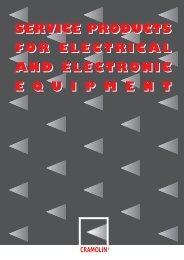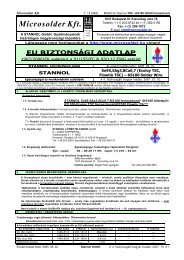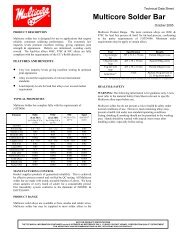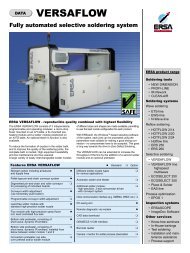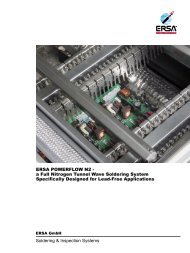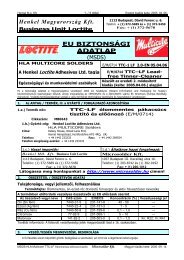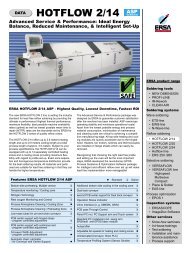high-speed printing no-clean solder paste
high-speed printing no-clean solder paste
high-speed printing no-clean solder paste
You also want an ePaper? Increase the reach of your titles
YUMPU automatically turns print PDFs into web optimized ePapers that Google loves.
Product Data Sheet<br />
MP200<br />
December 2002<br />
HIGH-SPEED PRINTING<br />
NO-CLEAN SOLDER PASTE<br />
PRODUCT DESCRIPTION<br />
LOCTITE ® Product Multicore MP200 <strong>solder</strong> <strong>paste</strong>s have been<br />
formulated as <strong>no</strong>-<strong>clean</strong> <strong>solder</strong> <strong>paste</strong>s for <strong>high</strong> <strong>speed</strong> <strong>printing</strong> and<br />
reflow in both air and nitrogen. The products were specifically<br />
formulated to have increased reflow process window.<br />
• Suitable for fine pitch, <strong>high</strong> <strong>speed</strong> <strong>printing</strong> up to 200mms -1 .<br />
• Extended printer open time and tack-life.<br />
• Prolonged between print abandon time.<br />
• Essentially colorless residues<br />
• Soft residues make pin testing easier eliminating any need for<br />
<strong>clean</strong>ing.<br />
• Resistant to both hot and cold slump.<br />
• 63S4 alloy for Anti-Tombstoning<br />
• ROL0 TO ANSI/J-STD-004<br />
Multicore MP200 <strong>solder</strong> <strong>paste</strong>s may be supplied with powder made<br />
from a range of alloys in the Multicore Product Range. The most<br />
common alloys used are Sn62 and Sn63 conforming to the purity<br />
requirements of J-STD-006 and EN 29453. Minimum order<br />
requirements may apply to certain alloys and powder particle sizes.<br />
TYPICAL APPLICATIONS<br />
Multicore MP200 is a <strong>high</strong> activity No-Clean flux that will be suitable<br />
for most assembly processes. It is especially suited to meet the<br />
demands of <strong>high</strong> volume production processes using components<br />
and boards that have less than the desirable level of <strong>solder</strong>ability.<br />
The enhanced activity level of MP200 produces greater tolerance to<br />
process variations and lower tendency to <strong>solder</strong> balling. The<br />
extended between print abandon time makes MP200 also suitable for<br />
<strong>high</strong> mix production.<br />
63S4 ANTI-TOMBSTONING ALLOY<br />
Where tombstoning is a particular process problem then<br />
63S4 alloy may offer an instant solution. 63S4 alloy is a<br />
blend of different melting point alloys with a special mix<br />
of <strong>solder</strong> particle sizes. This modification extends the<br />
melting range of the alloy hence reducing the possibility<br />
that one <strong>solder</strong> deposit at a component termination can<br />
fully reflow before the other.<br />
TYPICAL PROPERTIES<br />
The properties of <strong>solder</strong> <strong>paste</strong> depend in part on the metal content,<br />
the <strong>solder</strong> alloy and the <strong>solder</strong> particle size range. In general terms<br />
increasing metal content reduces the tendency to slump and reduces<br />
the tack life of the <strong>solder</strong> <strong>paste</strong>, while the <strong>solder</strong> balling performance<br />
improves.<br />
It is common practice to characterize the rheology of <strong>solder</strong> <strong>paste</strong>s by<br />
making a viscosity measurement at a single specified<br />
shear condition. Increasing metal content increases the measured<br />
value. Higher metal contents and decreasing the mean <strong>solder</strong><br />
powder particle size can have a similar effect. A plot of viscosity<br />
versus shear rate provides a more informative indication of the<br />
rheological properties of <strong>solder</strong> <strong>paste</strong>s. This data can be summarized<br />
as the "Thixotropic Index" of a <strong>paste</strong>.<br />
Typical properties of a selected Multicore MP200 <strong>solder</strong> <strong>paste</strong> are as<br />
follows. Full details of test methods will be supplied on request.<br />
Properties<br />
MP200<br />
Alloy Sn63 Sn62 63S4<br />
Metal Content, % 90 90<br />
Powder Particle Size, µm 45-25 38-10<br />
Powder Particle Size, J-Std-005 Type 3 N/A<br />
Powder Particle Size, Multicore<br />
AGS<br />
ACP<br />
Code<br />
Viscosity measured at 25°C<br />
Brookfield, P (1)<br />
Malcolm / p (2)<br />
Thixotropic Index, TI (3)<br />
680,000<br />
1350<br />
0.61<br />
680,000<br />
1400<br />
0.58<br />
Slump, J-Std-005 (4)<br />
8 mils stencil.<br />
Room temp<br />
150°C<br />
4 mils stencil<br />
Room temp<br />
150°C<br />
Tack (5)<br />
Initial tack force, gmm -2<br />
Useful open time, hours<br />
Shelf Life<br />
Horizontal pads<br />
80 x 25 mil<br />
13 mil<br />
13 mil<br />
80 x 13 mil<br />
3.2 mil<br />
3.2 mil<br />
80 x 25 mil<br />
13 mil<br />
13 mil<br />
80 x 13 mil<br />
3.2 mil<br />
3.2 mil<br />
1.1<br />
>24 hr<br />
80 x 13<br />
mil<br />
3.2 mil<br />
3.2 mil<br />
80 x 8 mil<br />
3.0 mil<br />
3.0 mil<br />
6 months refrigerated<br />
(1) Measured at 25°C, TF spindle at 5rpm after 2 minutes (typical)<br />
(2) Measured at 25°C, and a shear rate of 6s -1 (typical)<br />
(3) TI = log (viscosity at 1.8s -1 /Viscosity at18s -1 )<br />
(4) Slump data are expressed as the minimum spacing between pads of the size<br />
shown that does <strong>no</strong>t allow bridging<br />
(5) Tack data are derived from comparative laboratory tests and do <strong>no</strong>t necessarily<br />
relate directly to a particular user’s conditions<br />
Vertical Pads<br />
80 x 13 mil<br />
3.2 mil<br />
3.2 mil<br />
80 x 8 mil<br />
3.0 mil<br />
3.0 mil<br />
SOLDER POWDER:<br />
Careful control of the atomization process for production of <strong>solder</strong><br />
powders for MP200 <strong>solder</strong> <strong>paste</strong>s ensures that the <strong>solder</strong> powder is<br />
at least 97% spherical (aspect ratio
Test Specification Results<br />
Copper Plate Corrosion ANSI/J-STD-004 Pass<br />
Copper Mirror Corrosion ANSI/J-STD-004 Pass<br />
Chlorides & Bromides ANSI/J-STD-004 Pass<br />
Surface Insulation Resistance<br />
(without <strong>clean</strong>ing)<br />
ANSI / J-STD-004<br />
Bellcore GR-78-Core<br />
Pass<br />
Pass<br />
Electromigration<br />
Bellcore GR-78-Core Pass<br />
(without <strong>clean</strong>ing)<br />
Flux Activity Classification<br />
(without <strong>clean</strong>ing)<br />
ANSI/J-STD-004 ROL0<br />
range of the alloy.<br />
Typical reflow profile<br />
1. Ramp to 130 to 165 0 C at <strong>no</strong> more than 2 0 C s -1 .<br />
2. Hold at 130 to 165 0 C for 60 –120 seconds.<br />
3. Ramp to peak reflow temperature at <strong>no</strong> more than 2 0 C s -1 .<br />
4. Recommended peak reflow temperature is 205 0 C to<br />
225 0 C.<br />
5. Dwell time above liquidus of 30-75 seconds.<br />
GENERAL INFORMATION<br />
For safe handling information consult<br />
the material safety datasheet (MSDS)<br />
Lead exposure is harmful to your health. Lead is a<br />
toxic metal that produces a range of diverse health<br />
effects. Rosins contained in <strong>solder</strong> <strong>paste</strong> are<br />
potential sensitizers.<br />
DIRECTIONS FOR USE<br />
Application: MP200 <strong>solder</strong> <strong>paste</strong>s containing standard type (AGS)<br />
<strong>solder</strong> powder are formulated for <strong>high</strong>-volume stencil <strong>printing</strong><br />
applications with component lead pitches down to 0.4 mm. Improved<br />
print definition and consistency may be obtained for assemblies<br />
having 0201 passive components and 0.5 mm pitch array packages<br />
where the slightly finer anti-tombstoning (63S4 alloy) powder is used.<br />
Printing at up to 8″ s -1 (200 mm s -1 ) and down to 1.0″ s -1 (25 mm s -1 )<br />
can be achieved using laser cut electro-polished, or electroformed<br />
stencils and metal squeegees (preferably 60 0 ). This is due to a<br />
unique rheology, which ensures that the <strong>high</strong>er shear rate viscosity is<br />
relatively low and the thixotropic index is <strong>high</strong> e<strong>no</strong>ugh to give good<br />
print definition and slump resistance while maintaining good roll and<br />
drop off behavior. Unlike some <strong>paste</strong>s, <strong>high</strong> squeegee pressures are<br />
<strong>no</strong>t required (typically 0.5 to 1.0 lbs. per inch), making MP200<br />
particularly useful for second side <strong>printing</strong> processes.<br />
Acceptable first prints have been achieved at 16 mls (0.4mm) pitch<br />
after printer down times of greater than 90 minutes, without requiring<br />
a knead cycle.<br />
MP200 <strong>solder</strong> <strong>paste</strong>s do <strong>no</strong>t require the addition of thinners. The only<br />
conditioning that may be done is to stir the <strong>paste</strong> in the jar for 15<br />
seconds before introducing it to the stencil. Material in cartridges is<br />
conditioned by the shearing of the <strong>paste</strong> as it is expelled from the tip.<br />
REFLOW<br />
Any of the available methods of heating to cause reflow may be used<br />
including IR, convection, hot belt, vapor phase and laser <strong>solder</strong>ing. It<br />
is <strong>no</strong>t practicable to recommend an ideal reflow temperature profile<br />
for all situations; however, the following shows examples profiles that<br />
have given good results in practice. Where tombstone defects are<br />
experienced with standard alloys and it is <strong>no</strong>t possible to eliminate<br />
them by design changes then the 63S4 anti-tombstoning should be<br />
selected. Generally 63S4 alloy <strong>paste</strong> is a drop-in replacement for<br />
standard Sn63 or Sn62 alloys and in many cases <strong>no</strong> reflow process<br />
changes will be required. Note that the joint surface appearance of<br />
the 63S4 alloy is slightly less bright than those obtained from Sn62<br />
and Sn63 alloys, the effect is marginal and is due to the small melting<br />
CLEANING<br />
The residues from Multicore MP200 <strong>solder</strong> <strong>paste</strong>s may be left on the<br />
PCB in many applications since they do <strong>no</strong>t pose a hazard to longterm<br />
reliability. However, should there be a specific requirement for<br />
residue removal, this may be achieved using conventional <strong>clean</strong>ing<br />
processes based on solvents such as Multicore Prozone or suitable<br />
saponifying agents.<br />
For stencil <strong>clean</strong>ing and <strong>clean</strong>ing board misprints, Multicore SC-01<br />
Solvent Cleaner is recommended.<br />
PACKAGING<br />
MP200 <strong>solder</strong> <strong>paste</strong>s are supplied in:<br />
• Various package sizes and types are available.<br />
• Manual Repair Paste for Sn62/63 in 30cc syringes for manual<br />
dispense only<br />
• Tacky Flux in various package sizes<br />
SHELF LIFE<br />
Provided Multicore MP200 <strong>solder</strong> <strong>paste</strong>s are stored tightly sealed in<br />
the original container at 5-10°C, a minimum shelf life of 6 months can<br />
be expected. Air shipment is recommended to minimize the time that<br />
containers are exposed to <strong>high</strong>er temperatures. Short-term storage at<br />
room temperature during use is acceptable providing the <strong>paste</strong> is<br />
sealed in original containers.<br />
STORAGE<br />
It is recommended to store MP200 at 5-10°C, (NB cartridges should<br />
be stored tip down to prevent the formation of air pockets). The <strong>paste</strong><br />
should be removed from cold storage a minimum of 8 hours prior to<br />
use. Multicore MP200 <strong>solder</strong> <strong>paste</strong>s have been formulated to reduce<br />
separation on storage to a minimum but should this occur, gentle<br />
stirring for 15 seconds will return the product to its correct rheological<br />
performance.<br />
To prevent contamination of unused product do <strong>no</strong>t return any<br />
material to its original container. For further specific shelf life<br />
information contact your local Technical Service Center.<br />
DATA RANGES<br />
The data contained herein may be reported as a typical value and/or<br />
range. Values are based on actual test data and are verified on a<br />
periodic basis.<br />
250<br />
200<br />
Temperature/ o C<br />
150<br />
100<br />
50<br />
0<br />
0 1 2 3 4 5 6 7<br />
Time/minutes
Note<br />
The data contained herein are furnished for information only and<br />
are believed to be reliable. We can<strong>no</strong>t assume responsibility for<br />
the results obtained by others over whose methods we have <strong>no</strong><br />
control. It is the user's responsibility to determine suitability for<br />
the user's purpose of any production methods mentioned herein<br />
and to adopt such precautions as may be advisable for the<br />
protection of property and of persons against any hazards that<br />
may be involved in the handling and use thereof. In light of the<br />
foregoing, Loctite Corporation specifically disclaims all<br />
warranties expressed or implied, including warranties of<br />
merchantability or fitness for a particular purpose, arising<br />
from sale or use of Loctite Corporation’s products. Loctite<br />
Corporation specifically disclaims any liability for<br />
consequential or incidental damages of any kind, including<br />
lost profits. The discussion herein of various processes or<br />
compositions is <strong>no</strong>t to be interpreted as representation that they<br />
are free from domination of patents owned by others or as a<br />
license under any Loctite Corporation patents that may cover<br />
such processes or compositions. We recommend that each<br />
prospective user test his proposed application before repetitive<br />
use, using this data as a guide. This product may be covered<br />
by one or more United States or foreign patents or patent<br />
applications.<br />
Loctite UK Ltd, Watchmead, Welwyn Garden City, Hertfordshire, AL7 1JB<br />
MSL 922<br />
Loctite is a Trademark of Loctite Corporation U.S.A.



